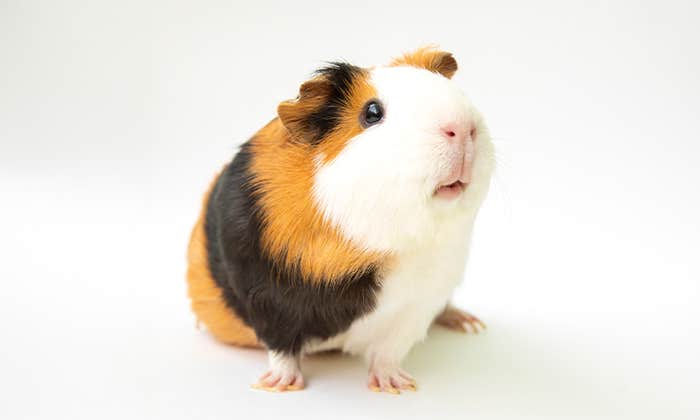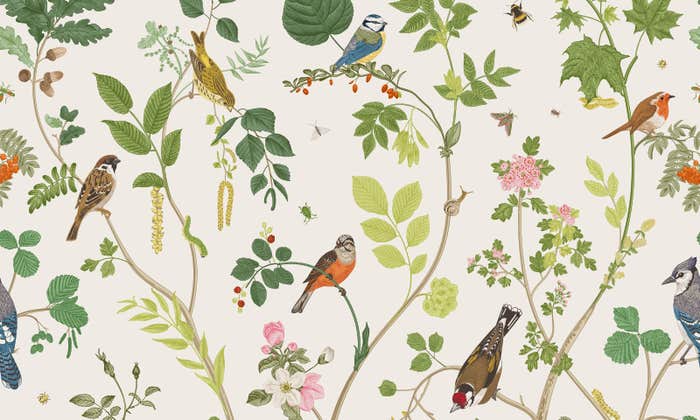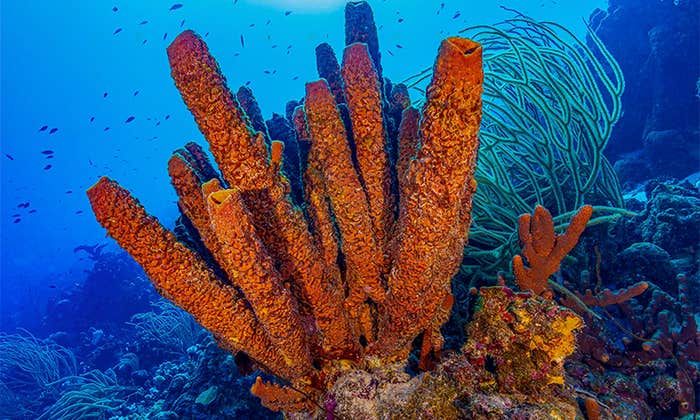When the HMS Beagle dropped anchor on San Cristobal, the easternmost island in the Galapagos archipelago, in September 1835, the ship’s naturalist Charles Darwin eagerly went ashore to gather samples of the insects, birds, reptiles, and plants living there. At first, he didn’t think much of the arid landscape, which appeared to be “covered by stunted, sun-burnt brushwood…as leafless as our trees during winter” But this did not put him off. By the time the Beagle left these islands some five weeks later, he had amassed a spectacular collection of Galapagos plants.
It is fortunate that he took such trouble. Most popular narratives of Darwin and the Galapagos concentrate on the far more celebrated finches or the giant tortoises. Yet when he finally published On the Origin of Species almost 25 years later, Darwin made no mention of these creatures. In his discussion of the Galapagos, he dwelt almost exclusively on the islands’ plants.
By the early 19th century, there was increasing interest in what we now refer to as biogeography, the study of the distribution of species around the globe. Many people still imagined that God had been involved in the creation of species, putting fully formed versions down on Earth that continued to reproduce themselves, dispersing from a divine “center of creation” to occupy their current habitats. To explain how the plants and animals reached far-flung places such as the isolated Galapagos, several naturalists imagined that there had to have been land bridges, long-since subsided, that had once connected them to a continent. But in the wake of the Beagle voyage, the collection of Galapagos plants suggested an alternate scenario.
But when the botanist began to study the leaf structure and the flowers and seeds in minute detail, he was in for a big surprise.
Even if there had once been a land bridge to the islands, it could not account for the fact that half of the plant species Darwin collected were unique to the Galapagos, and that most of them were particular to just one island. “I never dreamed that islands, about fifty or sixty miles apart, and most of them in sight of each other, formed of precisely the same rocks, placed under a quite similar climate, rising to a nearly equal height, would have been differently tenanted,” wrote Darwin in his Journal of Researches. His observations could be best explained if species were not fixed in nature but somehow changed as the seeds traveled to different locations.
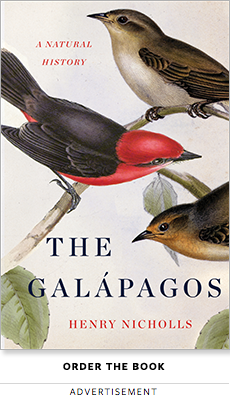 In order to make that conjecture, Darwin needed to classify the plants. Given his limited botanical expertise, he turned to a young botanist named Joseph Dalton Hooker. Darwin was excited to find out the number of different plant species he’d collected and their distribution across the archipelago. At first, Hooker did not anticipate a huge amount of novelty. “The species will no doubt be peculiar but they may not form peculiar genera of more than one or two species.” In other words, he expected most of the Galapagos plants to fit into the established botanical framework.
In order to make that conjecture, Darwin needed to classify the plants. Given his limited botanical expertise, he turned to a young botanist named Joseph Dalton Hooker. Darwin was excited to find out the number of different plant species he’d collected and their distribution across the archipelago. At first, Hooker did not anticipate a huge amount of novelty. “The species will no doubt be peculiar but they may not form peculiar genera of more than one or two species.” In other words, he expected most of the Galapagos plants to fit into the established botanical framework.
But when the botanist began to study the leaf structure and the flowers and seeds in minute detail, he was in for a big surprise. “The Galapagos plants are far more extensive in number of species than I could have supposed,” he wrote to Darwin in great excitement in late 1843.
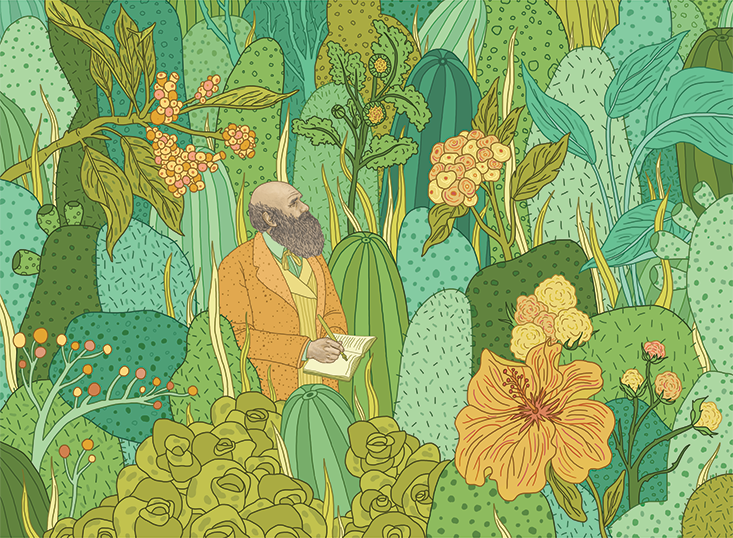
Although they resembled the vegetation from mainland South America, almost half of the flora appeared to be endemic, found only in the Galapagos. Even more interestingly, Hooker noted that almost every species of flowering plant and fern that he described was confined to just one island. This “most strange fact,” wrote Hooker, “quite overturns all our preconceived notions of species radiating from a centre.” Rather, each different island had its own similar, yet different flora.
Darwin, in turn, was ecstatic. “I cannot tell you how delighted & astonished I am at the results of your examination; how wonderfully they support my assertion on the differences in the animals of the different islands.” In addition to Hooker’s insights into the distribution of plants in the Galapagos, his paper On the Vegetation of the Galapagos Archipelago contained some very interesting speculation about how plants had got to the islands in the first place. For example, Hooker noted that in comparison to the tropical plants from the continent, the Galapagos flora contained a far smaller proportion of a particular kind of flowering plant. Perhaps, he suggested, there might have been “obstacles to the transport of seeds from the continent.” He went on to suggest four main routes through which plants might have reached the Galapagos. “The means of transport which may have introduced these plants are, oceanic and aerial currents, the passage of birds and man,” he wrote.
If you have a fussy reproductive set-up, the odds of surviving on a remote island in somewhere like the Galapagos are stacked against you.
Hooker guessed that most of the species found near the coast had probably reached Galapagos by floating, their tough seeds helping them “in resisting for some time the effects of salt water.” There were also some species beyond the coast with seeds “too large for probable transport by winds” and “no means of attaching themselves to birds” that had probably also taken an oceanic route to Galapagos. Hooker felt that it was only species with small seeds or those “furnished with wings or other appendages” that might have arrived on the wind. Birds, he felt sure, could account for many of the presence of many of the plant species lying further from the coast. It was known that humans had visited the Galapagos so it was clear that they had brought plants too, for Floreana—then the only inhabited island—was the only one with a significant number of plants that could be exploited as food.
In 1855, Darwin put his mind to testing some of Hooker’s predictions. He began by playing around with seeds and seawater at his home in the English countryside south of London. He kicked off with species he could easily get his hands on—cress, radish, cabbage, lettuce, carrot, celery, and onion—just to establish whether seawater kills seeds. It was a question he admitted “might naturally appear childish to many,” but one that produced some intriguing results and unexpectedly profound conclusions.
He left the seeds in salt water for a week before planting them in little pots. To his surprise, they all germinated. “It is quite surprising that the Radishes shd have grown, for the salt-water was putrid to an extent, which I cd not have thought credible had I not smelt it myself,” he wrote. He went further, buying seeds of still more species and gradually extending the length of time they were immersed in his seawater concoction. By the time he published On the Origin of Species in 1859, he had exposed the seeds of 87 different plant species to these hostile conditions. Incredibly, nearly all of them germinated after stewing in brine. Some survived just days, but others still seemed in perfectly good working order after several months.
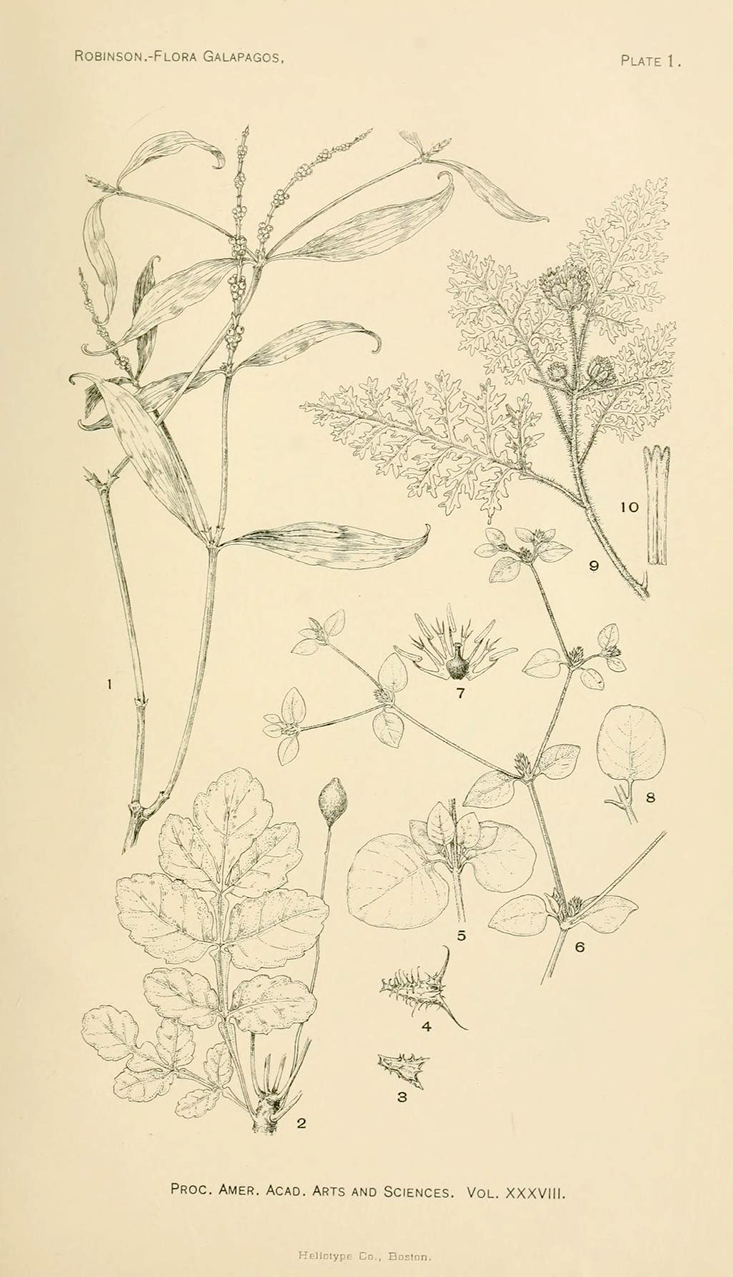
Suddenly, the vast expanse of salty ocean between South America and the Galapagos did not seem to be such an obstacle. There was, however, a snag: A lot of the seeds he experimented with sank and would have been lost in the oceanic depths long before reaching the Galapagos. But Darwin had an answer to this, discovering that the condition of the seed affects its buoyancy. “For instance, ripe hazel-nuts sank immediately, but when dried, they floated for 90 days and afterwards when planted they germinated,” he wrote in On the Origin of Species. Likewise, “an asparagus plant with ripe berries floated for 23 days, when dried it floated for 85 days, and the seeds afterwards germinated.”
Even a seed that sinks, Darwin realized, might still be carried on ocean currents if it hitches a ride on a clod of earth attached to the roots of some big tree or is protected inside the carcass of a dead animal. To illustrate this possibility, he fed a pigeon on seeds that would normally be “killed by even a few days’ immersion in sea-water.” He then sacrificed it and floated its body on salty water for a month. To his great surprise (and, one imagines, satisfaction), the delicate seeds “nearly all germinated.”
If most seeds could survive weeks in seawater, would they be able to reach remote islands like the Galapagos intact? Darwin hauled A. K. Johnston’s Physical Atlas from his bookshelf and worked out that the Atlantic currents run at an average of 33 miles per day, fast enough to carry a significant proportion of seeds a very long way before they either sank or succumbed to the salty insult. In the case of the Galapagos, the current that flows out from continental South America runs considerably faster, often around twice Johnston’s Atlantic average. So a back-of the-envelope calculation suggests that a seed—either floating or hitching a ride—could reach the Galapagos in just over nine days. Those species with the most delicate seeds might not make it. But a lot of species would.
Although some Galapagos plants clearly came on ocean currents and others on the wind, it’s thought that most Galapagos plants arrived with help from birds. “Living birds can hardly fail to be highly effective agents in the transportation of seeds,” Darwin wrote in the Origin. Obvious as it might be, he still sought evidence, going out into his garden in search of bird droppings. “In the course of two months,” he wrote, “I picked up in my garden 12 kinds of seeds, out of the excrement of small birds, and these seemed perfect, and some of them, which I tried, germinated.” He also dug around in the mud and showed it was full of seeds, in one instance a small cupful of sludge from a nearby pond producing more than 500 little plant shoots. “I think it would be an inexplicable circumstance if water-birds did not transport the seeds of fresh-water plants to vast distances,” he wrote.
Once a plant had become established in an isolated spot like an island in the Galapagos, Darwin felt that the “preservation of favorable variations and the rejection of injurious variations” would eventually result in the origin of new species, a process he termed “natural selection.” “I can see no limit to the amount of change, to the beauty and infinite complexity of the coadaptations between all organic beings, one with another and with their physical conditions of life, which may be effected in the long course of time by nature’s power of selection,” he wrote in the Origin.
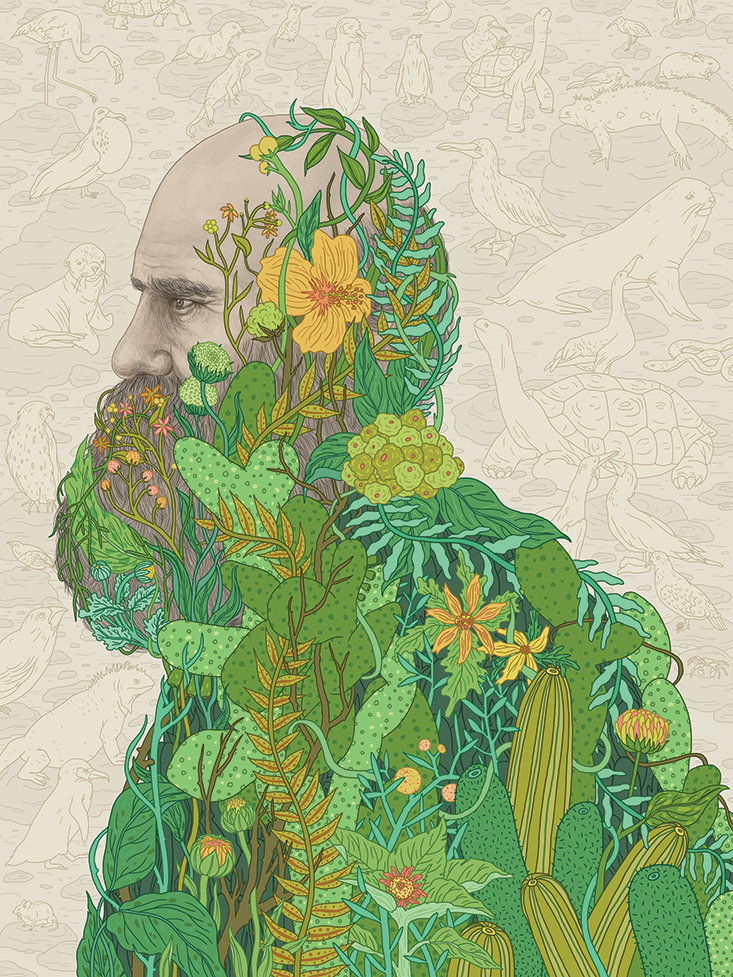
Darwin did not go into detail about how the first seeds to reach Galapagos entered into this “struggle for life.” Almost 180 years after his visit, however, there is plenty of evidence for such adaptation. One of the most telling observations, made in the 1980s, is that the vast majority of flowering plants in the Galapagos are capable of self-pollination. Darwin would have loved this observation and reveled in the explanation. If you have a fussy reproductive set-up, like a flowering plant that relies on a special insect to carry pollen to a fellow member of your species, the odds of surviving on a remote island in somewhere like the Galapagos are stacked against you. This also accounts for the fact that most flowering plants in the archipelago, with no need to attract insects, are not particularly showy (white or yellow petals are the norm).
In fact, there is evidence of adaptation everywhere in Galapagos. Near the coast, we see plants that are tolerant of dry, salty conditions. The red mangrove, for instance, is able to survive with specialized roots that can draw water from the sea without bringing too much salt on board. The leaves of black mangroves also contain salt glands capable of shifting salt from the inside to the outside of the plant.
Darwin’s collection of Galapagos plants proved to be a vital inspiration for his ideas on evolution by natural selection.
Beyond the salty coastal region, the lowest reaches of each Galapagos volcano are dominated by the arid zone, where water—or the lack of it—is the perennial problem. On Santiago, Darwin stuck a thermometer into some brown soil, and the mercury rocketed up to almost 60 degrees Celsius (140 degrees Fahrenheit). It could have been yet still hotter, but Darwin’s thermometer only went so far. It takes a certain kind of plant—usually with rather special roots—to survive in such a parched environment. Take the prickly pear cacti of the genus Opuntia, for example. These have two kinds of roots: one superficial set of finer roots whose job it is to suck up every last drop of water in the aftermath of a downpour, and a deeper “tap” root, which gives the plant a stronger hold on the rocks and searches out deeper sources of water. Life in the arid zone is also easier if you are capable of storing water, something that cacti are famous for. Their leaves, after all, have been so modified that we call them spines—and these modifications are a perfect way to cut down on water loss.
During the cool season, between June and November, a cool mist hovers at between 500 meters and 1,000 meters1 above sea level, creating a lush, moist zone, overrun with effulgent flora of an altogether different kind. When Darwin experienced the transition from the arid to the humid zone, it struck him too. Landing at Black Beach on Floreana (where the small town of Puerto Velasco Ibarra now stands), he walked about 8 kilometers inland, where he was thrilled “to find black mud & on the trees to see mosses, ferns & Lichens & Parasitical plants adhaering.”
Darwin’s collection of Galapagos plants proved to be a vital inspiration for his ideas on evolution by natural selection. In 1837, his bird specimens—particularly the Galapagos mockingbirds—alerted him to the possibility that the Galapagos flora and fauna would be allied with the productions of South America, that there would be an extraordinarily high level of novelty, and that most new species would be confined to a single island. But his failure to record the island of origin for many of his bird specimens meant that they could not furnish him with the robust evidence to support or refute his suspicions.
Darwin’s Galapagos plants, however, were fit for purpose. Hooker’s initial assessment confirmed that the Galapagos flora was indeed allied to that of South America, that there were lots of endemic species, and that many of these novelties seemed to be confined to just one island. These conclusions reached Darwin in early 1845, just in time for him to weave them into the second edition of his Journal of Researches. The chapter on the Galapagos ballooned to accommodate the new material and he became bolder with his conclusions.
“Reviewing the facts here given,” he wrote, “one is astonished at the amount of creative force, if such an expression may be used, displayed on these small, barren, and rocky islands.” And it was in direct response to Hooker’s findings that Darwin reached the following, now-famous conclusion: “Both in space and time, we seem to be brought somewhat near to that great fact—that mystery of mysteries—the first appearance of new beings on this earth.”
Henry Nicholls is the author of Lonesome George, which was shortlisted for the Royal Society Book Prize, and the forthcoming The Galapagos. He lives in London.
Adapted from The Galapagos: a Natural History by Henry Nicholls. Available from Basic Books, a member of the Perseus Books Group. Copyright © 2014





















